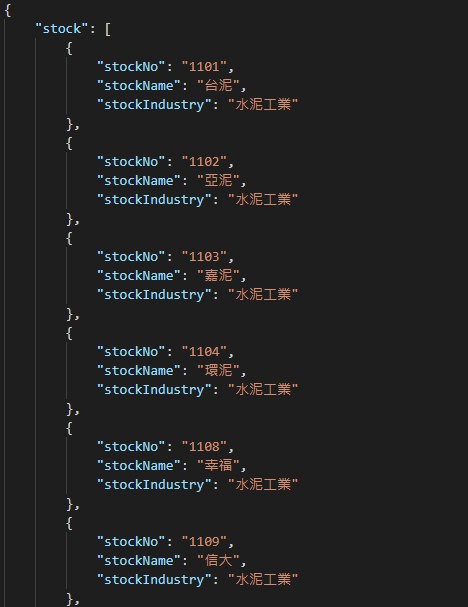[Python 爬虫这样学,一定是大拇指拉!] DAY23 - 实战演练:HTML Response - 抓取股票代码清单 (2)
开始前我简单带过一下我们这支爬虫 Beautiful soup 的用法好了:
from bs4 import BeautifulSoup
html = "<title>example1</title><title>example2</title>"
soup = BeautifulSoup(html, "lxml")
# find_all() 会搜寻整个 html 回传符合的值
print(soup.find_all("title"))
# [<title>example1</title>, <title>example2</title>]
# find() 只会回传"第一个"符合的值
print(soup.find("title"))
# <title>example1</title>
# 拿取 tag 之间的 text
print(soup.find("title").text)
# example1
大概是这样,其实没有很难对吧!![]()
那麽,要开始罗!
抓取股票代码清单 - 程序
-
根据前篇得到的资讯:
- URL:
https://isin.twse.com.tw/isin/class_main.jsp。 - 必要的 Query:
market=1&issuetype=1&Page=1&chklike=Y。 - 所以可以根据需求在 Query 的 market、issuetype、Page、chklike 代入自己要的值。
- HTTP Method 是 GET。
- Content-Type:text/html;charset=MS950,所以格式是 HTML,编码为 MS950。
- URL:
-
爬虫程序:
Beautiful soup 看不懂的地方,请开启上方提供的官方文件传送门搭配使用。
import json import requests from bs4 import BeautifulSoup # 设置 index constant,数字代表我们要的资料在 list 的位置 TARGET_TABLE_INDEX = 1 STOCK_NO_INDEX = 2 STOCK_NAME_INDEX = 3 STOCK_INDUSTRY_INDEX = 6 # JSON settings TITLE = "stock" JSON_INDENT = 4 # 送出 HTTP Request url = "https://isin.twse.com.tw/isin/class_main.jsp" res = requests.get(url, params={ "market": "1", "issuetype": "1", "Page": "1", "chklike": "Y" }) # 处理编码,使用预设 utf-8 的话 res.text 的内容会有乱码 res.encoding = "MS950" res_html = res.text # Parse soup = BeautifulSoup(res_html, "lxml") # 因为这个 HTML 里面有两张 table # 所以我们 find_all("table") 回传的 list 的 length 会是 2 # 而我们要的资料在第二张 tr_list = soup.find_all("table")[TARGET_TABLE_INDEX].find_all("tr") # tr_list 的第一个是 item 是栏位名称 # 我们这边用不到所以 pop 掉 tr_list.pop(0) # 开始处理资料 result = [] for tr in tr_list: td_list = tr.find_all("td") # 股票代码 stock_no_val = td_list[STOCK_NO_INDEX].text # 股票名称 stock_name_val = td_list[STOCK_NAME_INDEX].text # 股票产业类别 stock_industry_val = td_list[STOCK_INDUSTRY_INDEX].text # 整理成 dict 存起来 result.append({ "stockNo": stock_no_val, "stockName": stock_name_val, "stockIndustry": stock_industry_val }) # 将 dict 输出成档案 stock_list_dict = {TITLE: result} with open("stock_info_list.json", "w", encoding="utf-8") as f: f.write( json.dumps(stock_list_dict, indent=JSON_INDENT, ensure_ascii=False) )档案就会长这样:

以上就是抓取股票清单的方法!
<<: Day 25 : Tkinter实战,配合pillow制作简易的处理照片程序(上)
>>: D28 - 用 Swift 和公开资讯,打造投资理财的 Apps { 三大法人成交比重实作.3 }
自己做个好用的pysdie 2 cheat sheet
在很多地方都流行可以随时查找的cheatsheet,那PySide2 有吗? 笔者不清楚,乾脆直接做...
今日爬山中
初版待更新(还是翻新),9月19日中秋节前夕,爬山旅行中。 网路收讯极差,慌张的寻找网路与讯号点。 ...
LeetCode解题 Day17
350. Intersection of Two Arrays II https://leetcod...
DAY 15 『 Realm 新增、修改、删除 』Part3
昨天分享如何新增、修改、删除、印出 Realm 资料库的资料,以及读取 Realm 资料库的资料去更...
Day 25 constructors、this、static
constructors : Java 中建立物件需要建构子,如果类别没有定义建构子,编译器就会提供...